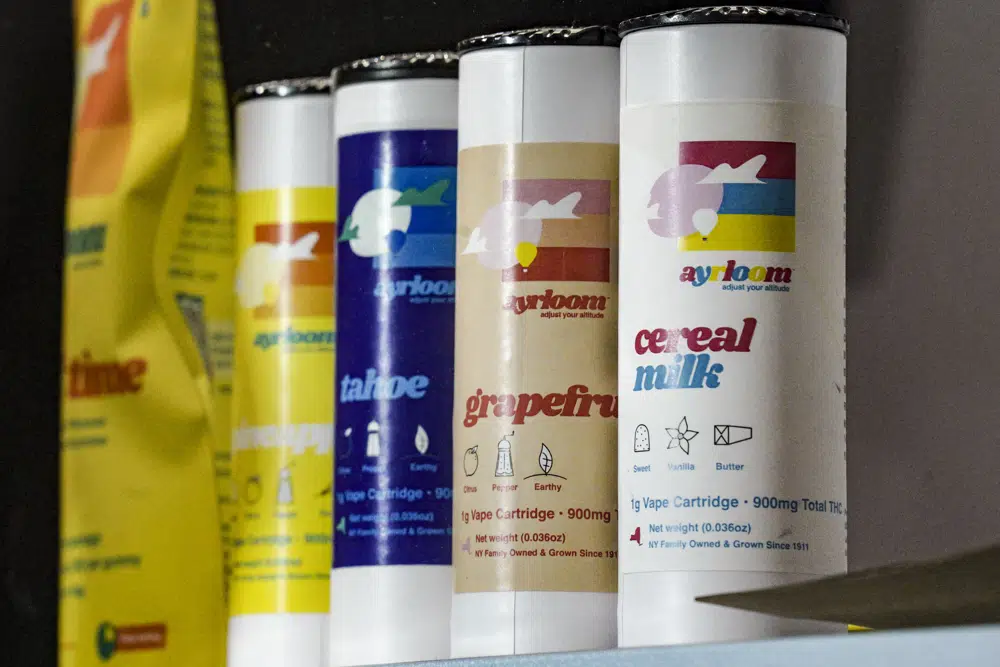NEW YORK (AP) — When New York’s first licensed recreational marijuana outlet opened last month, the chief of the state’s Office of Cannabis Management, Chris Alexander, proudly hoisted a tin of watermelon-flavored gummies above the crowd.
Outside the Manhattan shop, he displayed another purchase — a jar containing dried flowers of a cannabis strain called Banana Runtz, which some aficionados say has overtones of “fresh, fruity banana and sour candy.”
Inside the store run by the nonprofit Housing Works, shelves brimmed with vape cartridges suggesting flavors of pineapple, grapefruit and “cereal milk,” written in rainbow bubble letter print.
For decades, health advocates have chided the tobacco industry for marketing harmful nicotine products to children, resulting in more cities and states, like New York, outlawing flavored tobacco products, including e-cigarettes.
Now as cannabis shops proliferate across the country, the same concerns are growing over the packaging and marketing of flavored cannabis that critics say could entice children to partake of products labeled “mad mango,” “loud lemon” and “peach dream.”
“We should learn from the nicotine space, and I certainly would advocate that we should place similar concern on cannabis products in terms of their appealability to youth,” said Katherine Keyes, a professor of epidemiology at Columbia University who has written extensively about the rise in marijuana use among young people.
Health
“If you go through a cannabis dispensary right now,” she said, “it’s almost absurd how youth oriented a lot of the packaging and the products are.”
Keyes added that public health policymakers — and researchers like her — are trying to catch up with an industry and marketplace that is rapidly expanding and evolving.
New York, which legalized recreational marijuana in March 2021, forbids marketing and advertising that “is designed in any way to appeal to children or other minors.”
But New York’s state Office of Cannabis Management has yet to officially adopt rules on labeling, packaging and advertising that could ban cartoons and neon colors, as well as prohibit depictions of food, candy, soda, drinks, cookies or cereal on packaging — all of which, the agency suggests, could attract people under 21.
Challenges of keeping flavored pot from kids
“Consumers need to be aware — parents need to be aware — if they see products that look like other products that are commonly marketed to kids, that’s an illicit market product,” said Lyla Hunt, OCM’s deputy director of public health and campaigns.
Hunt recently saw a cannabis product calling itself ”Stony Patch Kids” that she said looked like the popular candy “Sour Patch Kids.”
Similar products are being sold by the dozens of illegal pot dispensaries that operate out in the open and that officials worry are selling unsafe products. Once packaging and marketing standards are established, the illicit marketplace will likely not comply, experts say.
“We can regulate until we’re blue in the face. But the truth is, it’s a partnership between a compliant industry, strong regulations that are robust in their protections for youth and then with parents, too,” Hunt said.
Under state law, a minor in possession of marijuana would face a civil penalty of not more than $50. Licensed cannabis retailers who sell to minors face fines and the loss of their licenses, but no jail time.
Science has long established the addictive nature of nicotine and the health maladies associated with smoking tobacco, including cancer and emphysema.
Less settled are the health repercussions from vaping, particularly among children whose bodies and internal organs have yet to fully develop.
While smoking tobacco cigarettes has fallen among teens and young adults, the use of e-cigarettes and vapes has risen.
A handful of states — California, Massachusetts, New Jersey, New York, and Rhode Island — have bans on most flavored tobacco products, including e-cigarettes and vapes. An increasing number of cities, including New York City, also have similar bans.
But those rules need to be broadened to include marijuana, said Linda Richter with the Partnership to End Addiction, who says the issue has yet to be widely addressed.
“There is more scrutiny on the tobacco industry, and very, very little in terms of rules, regulations, scrutiny, limitations when it comes to the cannabis industry,” she said.
Because of the relative infancy of the legalized industry, she added, states have yet to coalesce rules on a single national standard. States often look to the federal government to set those standards, but marijuana remains illegal on the federal level.
“That’s a real issue where you don’t have the weight of the federal government in terms of standards of packaging and marketing,” to set parameters to avoid appealing marketing to young people, Richter said.
Anti-smoking groups, including the Campaign for Tobacco-Free Kids, have long railed against the tobacco industry for its marketing, such as using cartoon characters to help market their products. In more recent years, they’ve campaigned against flavored nicotine products, including those in vaping form.
But thus far, such groups have not put the marijuana industry in its crosshairs.
A study released earlier this month documented the steep rise in poisonings among young children, especially toddlers, who accidentally ate marijuana-laced treats.
The uptick in cases coincides with the rise in the number of states allowing the use of marijuana for medicine or recreation. Medical use of cannabis is currently allowed in 37 U.S. states, while 21 states allow recreational use.
“When you’re talking about strawberry-cheesecake, or mango, or cookies-and-cream flavors, it’s very difficult to argue that those are for older adults,” said Dr. Pamela Ling, the director for the Center for Tobacco Control Research and Education at the University of California in San Francisco.
“Folks who consider themselves to be more like cannabis aficionados,” she said, “would say that smoking a flavored cannabis product is like putting ketchup on your steak.”



